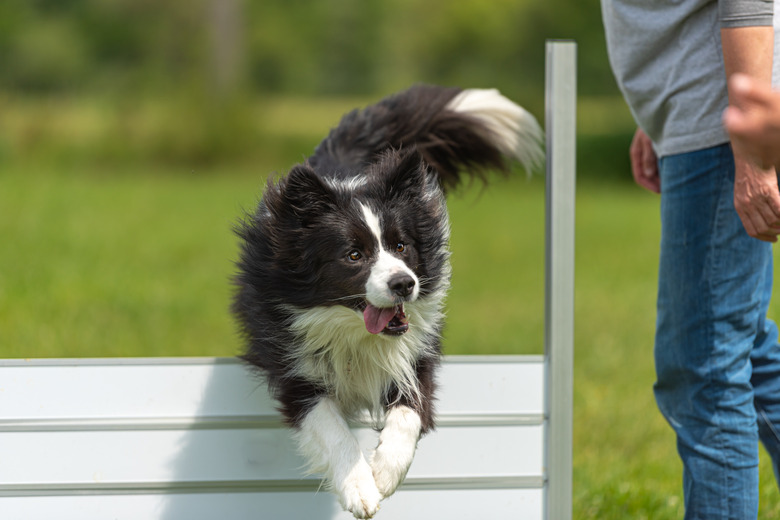What Are Aversives, And Why Shouldn't You Use Them?
When you have a dog, it can be overwhelming to figure out the best way to work with them. This is especially true for humans who have dogs that display challenging behaviors. When training a dog (or any animal), it's important to treat them humanely and avoid using aversives. Aversives are unpleasant responses to a dog's behavior during training sessions. Instead, positive reinforcement training can help your dog work through behaviors and improve them.
Dog training: an unregulated industry
Dog training: an unregulated industry
It's important to remember that dog training is an unregulated industry in the United States. Anyone can call themselves a "dog trainer," regardless of how much experience they have. This can sometimes lead to a wide array of "training methods" that promote outdated ideas and techniques. The use of aversive training is not only harmful to dogs, but it can also damage a dog's relationship with their human. That's why it's important to seek out a qualified, certified trainer to work with you and your dog.
What are aversives?
What are aversives?
In psychology, an aversive is an unpleasant stimulus that induce changes in behavior.
In animal training, aversives refer to a wide range of tools and behaviors that are painful and uncomfortable for dogs. Some common aversives you might be familiar with, which fall under the "positive punishment" quadrant of operant conditioning, include leash pops (pulling back on a dog's leash quickly), citronella spray collars, choke chains, prong collars, shock collars, or e-collars.
Aversives can also include using loud sounds to startle or upset a dog into changing a behavior. Examples include yelling, or shaking a a can full of rocks or coins in a dog's direction to startle them into stopping a behavior.
Aversive training approaches can also include negative reinforcement. Negative reinforcement means "the removal of something negative to strengthen a behavior." It is another quadrant of operant conditioning.
Examples of aversive training approaches that fall under negative reinforcement include: pushing a dog's (or other animal's) body until they comply with a "sit" or "down" position, applying leash pressure until a dog stops pulling, "alpha rolls" (physically pushing a dog onto their back), and other methods that rely on the pain or intimidation of an animal.
Unexpected aversives
Unexpected aversives
Beyond the obvious aversive techniques and tools, it's important to treat each dog as an individual and to understand what is aversive to them. For example, some dogs may enjoy spending time in their crate, because of their temperament and training. Other dogs may find crates to be very aversive. Another unexpected aversive a dog can experience is with people — through negative punishment within operant conditioning.
An example of a negative punishment could be a dog's human who turns away or leaves the room every time a dog jumps up — with the desired result being for a dog to jump less. This takes something a dog finds rewarding (like attention) and then takes it away until their behavior changes.
Aversives lead to confusion for dogs
Aversives lead to confusion for dogs
In addition to causing pain and discomfort, aversive tools and techniques can also be confusing for dogs. Aversive techniques don't shift a dog's feelings or understanding of a situation. Dogs tend to draw their own conclusions about what they are being punished for — which can lead to an increase in their undesirable behavior.
For example, if a dog receives a "collar correction" for barking and lunging when they see another dog approach, the dog may stop barking at that moment. However, because of the aversive collar, they may eventually associate the sight of another dog with pain and discomfort. This can increase and worsen their barking and lunging behavior when they try to make the other dog stay further away — to prevent their own pain from the collar correction. An aversive response from a human doesn't help a dog form new and positive associations with situations they find to be upsetting.
Training a dog with challenging behaviors
Training a dog with challenging behaviors
Just like we wouldn't spank or use other corporal punishment with our children, we shouldn't be using pain or intimidation with training our dogs — even when they do things we don't like. In the long run, the use of aversive techniques is likely to make a dog's unwanted behavior worse.
Using abusive aversives and punishing a dog for their natural responses to situations can lead a dog to experience an increase in anxiety and even more aggressive behavior. A 2007 study found that 59 percent of dog bites in homes are a direct result of individuals disciplining dogs with aversives. No dog should be subjected to a "firm hand" or other harmful aversive techniques to manage their behavior — regardless of what breed they are or what behaviors they are displaying.
Positive reinforcement techniques
Positive reinforcement techniques
Positive reinforcement training methods are far more effective, humane, and less confusing for dogs. Such methods should be used with all dogs, (including challenging dogs) regardless of age, size, or breed.
Positive reinforcement training allows us to proactively teach behaviors to our dogs and work through their problem behavior by developing their coping skills. Positive reinforcement methods use rewards like treats, toys, and play to proactively help dogs learn responses and behaviors that make them more comfortable, and easier to manage. It isn't just about giving a dog food rewards and hoping they then behave in the way we want. This training also uses force-free approaches to help dogs feel safe and comfortable in all of their interactions.
Positive reinforcement training can support dogs to develop new emotional responses to previously stressful situations, and to improve the dog and human relationship.
In summary
In summary
If you're teaching your dog new skills or working to shift undesirable behaviors, it's important to use positive reinforcement techniques. Humans should avoid using aversives when training and interacting with their dogs, or any other animal. Aversives include using tools that cause pain or discomfort, and any human interactions that make dogs feel intimidated or uncomfortable. Aversives don't promote desired behaviors in dogs. Instead, they lead to dogs being fearful or uncomfortable in the presence of their humans. Using aversive techniques can harm a dog's relationship with their family and can lead to their behavior becoming worse.



